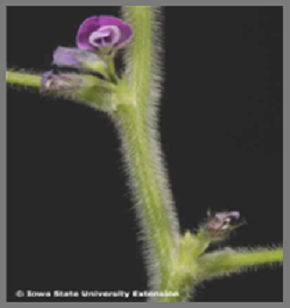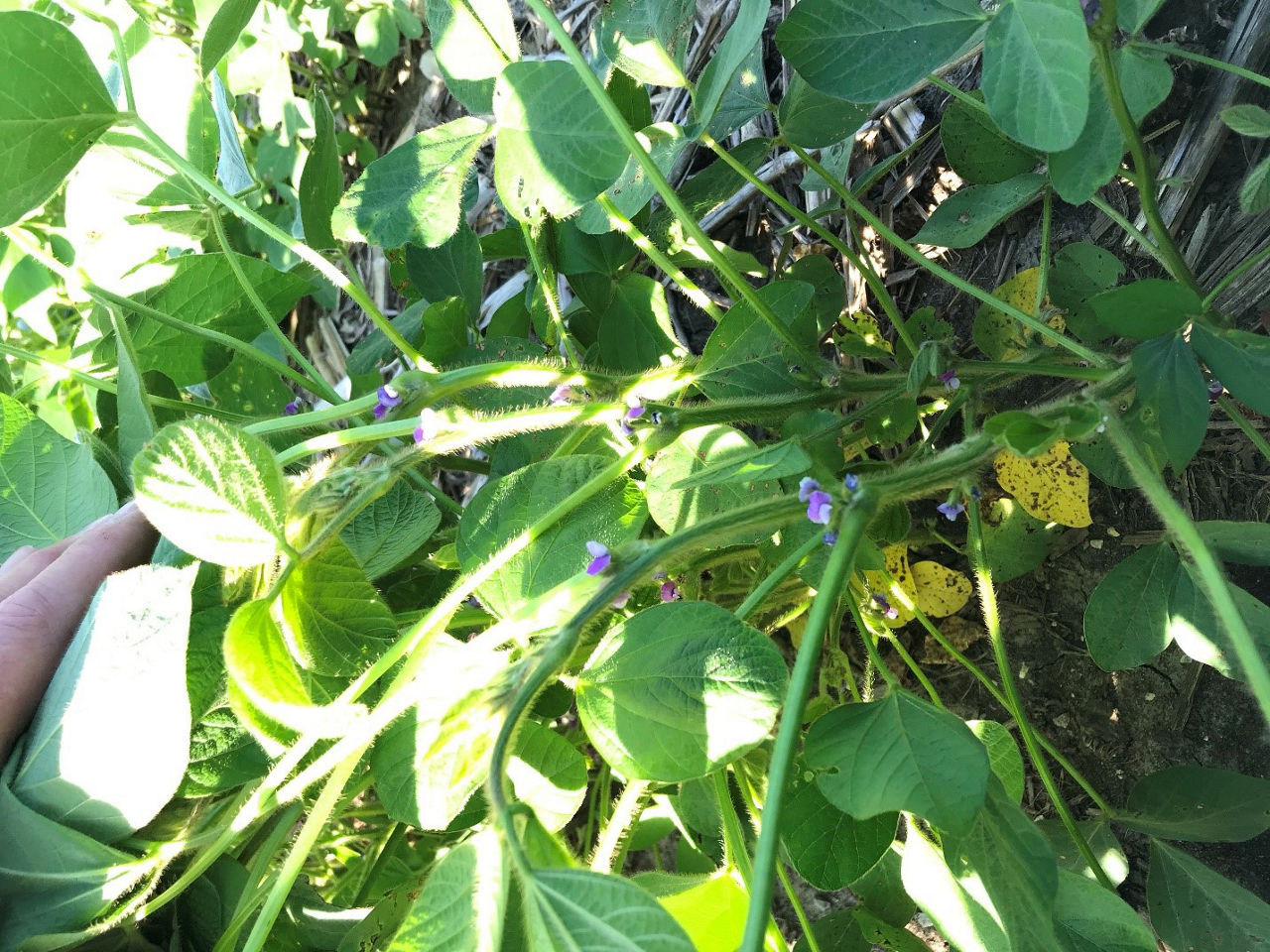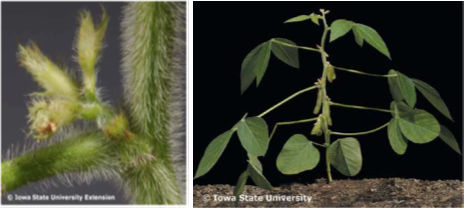5 MIN READ
Soybean Yield Components During R1 to R4 Growth Stage
July 26, 2023
Key Points
- Being able to identify a soybean crop stage and understand the components of that stage is important for guiding management decisions.
- Reproductive growth stages of soybean begin with flowering (R1-R2) and include pod development (R3-R4), seed development (R5-R6), and plant maturity (R7-R8).
- Stress on soybean plants during reproductive stages can impact the ability of plants to reach their full yield potential.
The ability to identify soybean growth stages can be an important part of crop management. Knowing what stage the crop is in and what developmental processes are part of that stage can help guide management decisions for better overall crop health and success. It is also important to understand the impact of stress at each of these stages and ways to avoid or minimize the impact of that stress.
Soybean vegetative growth stages are numbered according to the number of fully developed trifoliate leaves. Vegetative and reproductive growth stages overlap in soybean. Reproductive stages begin at flowering (R1-R2) and include pod development (R3-R4), seed development (R5-R6), and plant maturity (R7-R8). The crop’s growth stage is determined by the point at which 50% or more of the plants are in or beyond a specific stage.
Beginning Bloom (R1)
One open flower at any node on the main stem (Figure 1). This is a period of rapid growth. Soybean flowering begins on the third to sixth node of the main stem. Flowering continues up and down the main stem and eventually moves to branches. Since groups of flowers develop from the base to the tips of the plant, pods at the base of the plant are usually more mature than those at the tips. Vertical roots, secondary roots, and root hairs are growing rapidly during the R1 growth stage and continue until the R4 to R5 growth stages. Plants are about 15 to 18 inches tall and usually in vegetative growth stages V7 to V10. Stresses that might occur from R1 to R5 growth stages, such as defoliation or root damage, can affect growth rate and yield potential.

Full Flower (R2)
An open flower at one of the top two nodes on the main stem with a fully developed trifoliate leaf (Figure 2). One or more of the upper nodes has a fully developed leaf and approximately 50% of the total number of nodes have developed. Plants are in the V8 to V12 growth stages and are approximately 17 to 22 inches tall. Roots can completely cross the inter-row space in 30-inch rows. Major lateral roots have turned down into the soil and nitrogen fixation by root nodules is increasing. Plant dry mater is accumulating rapidly. During this stage of growth, plants can accumulate about one-fourth of their total dry weight and nutrients and obtain nearly 50% of mature height. Defoliation of 50% at this growth stage can potentially reduce yield by 6%.

Beginning Pod (R3)
At least one pod is 3/16 inch long at one of the four uppermost nodes with a fully developed trifoliate leaf (Figure 3). Plants are about 23 to 32 inches tall and in the V11 to V17 growth stages. Yield components can be divided into three categories: 1) total number of pods, 2) the number of seeds per pod, and 3) seed size. The number of seeds per pod and seed size are generally limited by the genetic background of the soybean variety. Stress during this growth stage may decrease one—or all—of these components. Because of the long flowering period, soybean plants can typically at least partially compensate for temporary stress. However, the plant loses this ability as it matures from R1 to R5. During the R3 growth stage, 60 to 75% of the flowers and as many as 50% of the formed pods can abort. Stress during this stage may increase abortion rates and decrease yield potential. Favorable growing conditions may increase pod number per plant and increase yield potential.
Full Pod (R4)
At least one pod is ¾ inch long at one of the four upper-most nodes with a fully developed trifoliate leaf (Figure 4). This stage marks the beginning of the critical period for determining soybean yield potential. Rapid pod growth and seed development are followed by finalization of pod number. Pod dry weight increases from the R4 to R5 growth stages. Stress during this period can cause more reduction in yield potential than at any other growth stage. Daily water use during this growth stage can be about 0.30 inches per day. This stage may be the most effective time to apply irrigation water to reduce potential yield loss.

Management Considerations
Stress management is one of the biggest obstacles that farmers face in crop production. Stress can occur in the form of weeds, insects, diseases, nematodes, lack of soil moisture, and a wide range of other environmental factors. While soybean crops seem to tolerate short periods of stress better than some other crops, any extended stress as plants reach reproductive stages impacts the ability of plants to reach their full yield potential.
Because stress factors can vary greatly across different geographies and field environments, the best place to start is to understand the risk factors for your particular farm. Monitor fields for pests and diseases throughout the season and keep track of those that are becoming problematic in surrounding areas. Treatment thresholds and recommendations for insect and disease infestations can vary by state. The period encompassing growth stages R1-R4 can be an effective time to apply insecticides and fungicides for some situations, but be sure to consult individual product labels for directions.
Sources:
Endres, G.J. and Kandel, H. 2021. Soybean growth and management quick guide. Publication number A-1174. North Dakota State University Extension. https://www.ndsu.edu/agriculture/ag-hub/publications/soybean-growth-and-management-quick-guide
Naeve, S. 2005. Growth and development (soybean). University of Minnesota Extension. https://extension.umn.edu/growing-soybean/soybean-growth-stages#days-between-stages-539862
Pedersen, P. 2014. Soybean growth and development. PM 1945. Iowa State University Extension and Outreach. https://crops.extension.iastate.edu/files/article/SoybeanGrowthandDevelopment_0.pdf
Web sources verified 07/20/2023. 1314_59101
Seed Brands & Traits
Crop Protection
Disclaimer
Always read and follow pesticide label directions, insect resistance management requirements (where applicable), and grain marketing and all other stewardship practices.
©2024 Bayer Group. All rights reserved.